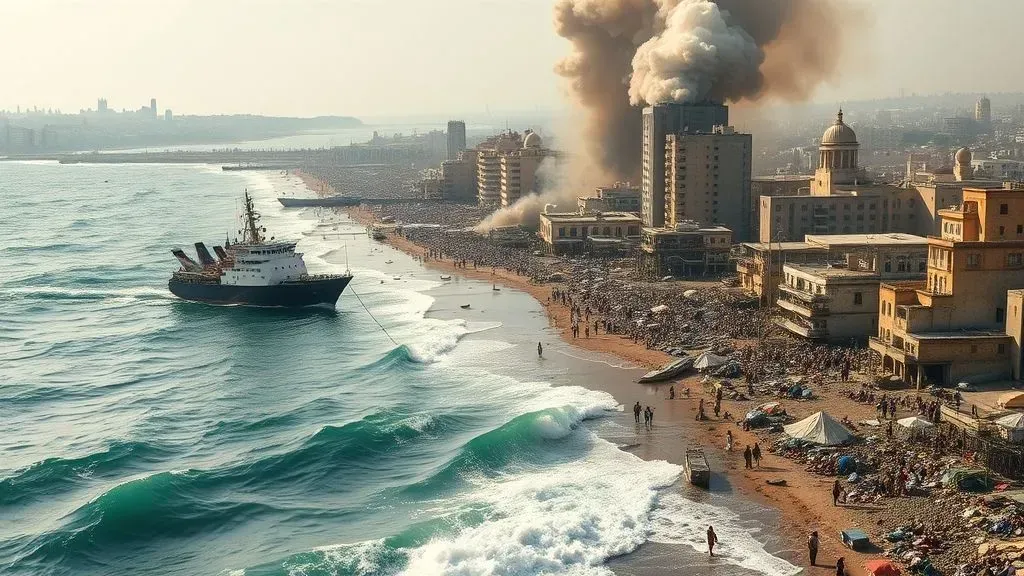
Thousands of Palestinians have fled Gaza City by boat in recent days, driven by one of the most intense bombardments since the conflict escalated. Israeli forces launched a major ground offensive on September 16, 2025, targeting northern areas and forcing mass evacuations.
United Nations officials describe the situation as cataclysmic, with airstrikes, artillery, and naval shelling creating unlivable conditions.
This exodus highlights the desperation, as families load belongings onto rudimentary vessels to navigate coastal routes south.
The Surge in Bombardment
Israeli military operations aim to dismantle remaining Hamas presence in Gaza City, where about 3,000 fighters reportedly remain.
Eyewitnesses report nonstop explosions from air, sea, and ground, displacing nearly a million people toward so-called safe zones like al-Mawasi.
According to Al Jazeera reports, the assault has turned urban centers into wastelands, with phone and internet services frequently cut.
Evacuation Challenges
Fleeing residents face overcrowded roads and risky sea paths, where boats often capsize under the weight of evacuees.
A BBC analysis notes that coastal escapes, though faster, expose civilians to naval threats and rough waters.
This method underscores the lack of viable land routes amid ongoing strikes.
Risks of Sea Flight
Many boats are makeshift, carrying families and essentials southward along Gaza's 40-kilometer coastline.
Israeli naval forces patrol these waters, raising fears of interception or accidental strikes on civilian vessels.
Humanitarian groups warn that such escapes could lead to drownings, especially for those without navigation aids.
Human Cost
Over 65,000 Palestinians have died in the broader conflict, with recent days adding hundreds more from bombardment alone.
Displaced individuals arrive in southern areas already strained by prior waves of refugees, lacking adequate shelter or supplies.
The International Red Cross highlights the psychological toll on children witnessing these perilous journeys.
Crypto's Role in Crisis Response
As traditional banking crumbles in Gaza, cryptocurrencies provide an essential alternative for aid distribution.
With infrastructure ruined, residents rely on Bitcoin and stablecoins like Tether for transactions and receiving funds from abroad.
According to The New Arab, these digital assets have become a lifeline, bypassing frozen accounts and cash shortages.
NFT Fundraisers Gain Traction
Non-fungible token projects have raised significant funds for Palestinian relief, channeling proceeds to evacuees and artists.
The Palestine Museum US launched an NFT collection in January 2025, supporting Gaza creators amid displacement.
These initiatives tokenize artwork and cultural artifacts, allowing global buyers to contribute while preserving heritage.
Blockchain for Transparent Aid
Crypto donations to organizations like UNRWA enable quick transfers to fleeing families, avoiding bureaucratic delays.
UNRWA USA partners with platforms like The Giving Block to accept over 40 cryptocurrencies, including Ethereum.
A Bitcoin Magazine profile details how individuals like taxi driver Yusef Mahmoud use Bitcoin to evacuate civilians, collecting donations peer-to-peer.
Challenges and Innovations
While effective, crypto aid faces scams and volatility, prompting verified NFT drops for accountability.
Projects like Okay Bears-Okay Cares released open-edition NFTs in March 2025, directing mint fees to humanitarian efforts in Gaza.
Blockchain ensures donors track fund usage, building trust in volatile regions.
NFTs Preserve Palestinian Culture
Displaced artists turn to NFTs to digitize and sell embroidery, paintings, and stories from Gaza.
Refugee women have hand-sewn digital representations of traditional coins into NFT collections, generating income for survival.
This approach not only funds escapes but also immortalizes narratives lost in bombardment.
Global Support via Web3
Solana-based tokens like Free Palestine (FPL) aim to pool community funds for Gaza aid, emphasizing transparency.
Analysts note that NFTs democratize philanthropy, allowing micro-donations from crypto holders worldwide.
Such tools empower Palestinians to maintain economic agency during flight and resettlement.
Future Implications for Aid
As sea evacuations continue, integrating NFTs into relief strategies could accelerate support delivery.
Experts from the International Rescue Committee suggest blockchain reduces corruption risks in war zones.
This fusion of technology and humanitarianism offers actionable paths for donors to impact real-time crises.
The relevance of NFTs in this context lies in their ability to bridge global empathy with on-ground needs, ensuring aid reaches those fleeing by sea amid Israel's bombardment.



